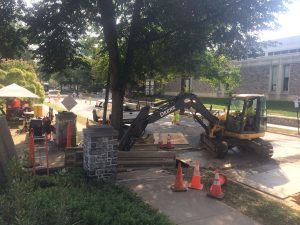 In his essay “The Beholding Eye: Ten Versions of the Same Scene,” D.W. Meinig suggests that a landscape can be viewed as “ideology,” shaped by the cultural values of the people who interact with it. Underlying every scene is a set of human ideas about their relationship to the landscape.Through this lens, this construction scene strongly reflects a philosophy of progress, and especially progress as mastery of our world. The road is a tool for mobility, which allows society to expand in space and allows people to command that space with as little effort as possible. We want everything interconnected, available at our convenience. The road signs further evoke this sense of control: they are evidence that this road is part of a carefully mapped network, broken down into numbered units. They reflect a Fordian notion of mechanization and uniformity, which also shows itself in every man made item in the scene. The vehicles, the workmen’s clothes, the construction tools all come from batches of identical items, pumped out by a mechanized production scheme.
In his essay “The Beholding Eye: Ten Versions of the Same Scene,” D.W. Meinig suggests that a landscape can be viewed as “ideology,” shaped by the cultural values of the people who interact with it. Underlying every scene is a set of human ideas about their relationship to the landscape.Through this lens, this construction scene strongly reflects a philosophy of progress, and especially progress as mastery of our world. The road is a tool for mobility, which allows society to expand in space and allows people to command that space with as little effort as possible. We want everything interconnected, available at our convenience. The road signs further evoke this sense of control: they are evidence that this road is part of a carefully mapped network, broken down into numbered units. They reflect a Fordian notion of mechanization and uniformity, which also shows itself in every man made item in the scene. The vehicles, the workmen’s clothes, the construction tools all come from batches of identical items, pumped out by a mechanized production scheme.
The construction work, meanwhile, demonstrates how laborious and imperfect our efforts are to maintain and achieve control. In this case, materials must be forced into place with heavy machinery to perform the purposes set for them. We keep at this task with stubborn persistence. Human use and natural elements wear away at our controlled structures, and the fight to hold degradation at bay can itself be disruptive. As this repair job progresses, a gaping hole in the ground fragments the sidewalk; the construction equipment blocks half the road. The traffic cones and crossing guards represent an attempt to gloss over this disruption of order.
While the process of development and mechanization is clear in the central and obtrusive construction scene, it has also solidified itself in the surroundings. The brick walls of the HUB are the product of yet another construction project, another battle for order and control. The stones are cut to fit perfectly together, in a pattern designed to fit human ideas of what is functional and attractive. The building provides a space where humans can have thorough control over their surroundings, where every surface can be straightened and leveled and even the lighting and temperature are mechanized. Meanwhile, the surrounding greenery provides an example of human control over other forms of life. Each tree, shrub and patch of grass is positioned and cultivated with the human eye and human convenience in mind.
This concern with aesthetics is linked with another aspect of progress: progression of social status. Everything surrounding the road is part of an institution of higher learning, whose reputation rests on its appearance as well as its academic quality. Its students work toward degrees as symbols of intelligence, discipline and expertise. Their education is intended as a pathway to respected careers and financial success. Through their education, the ideology of progress is passed on- but it can also be questioned and altered. With the evolution of ideas, the landscape continues to evolve.
